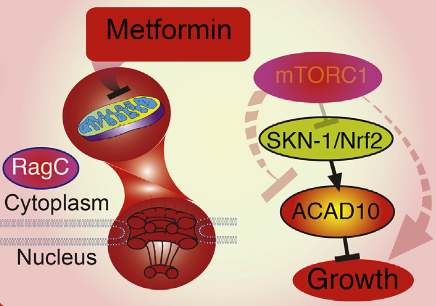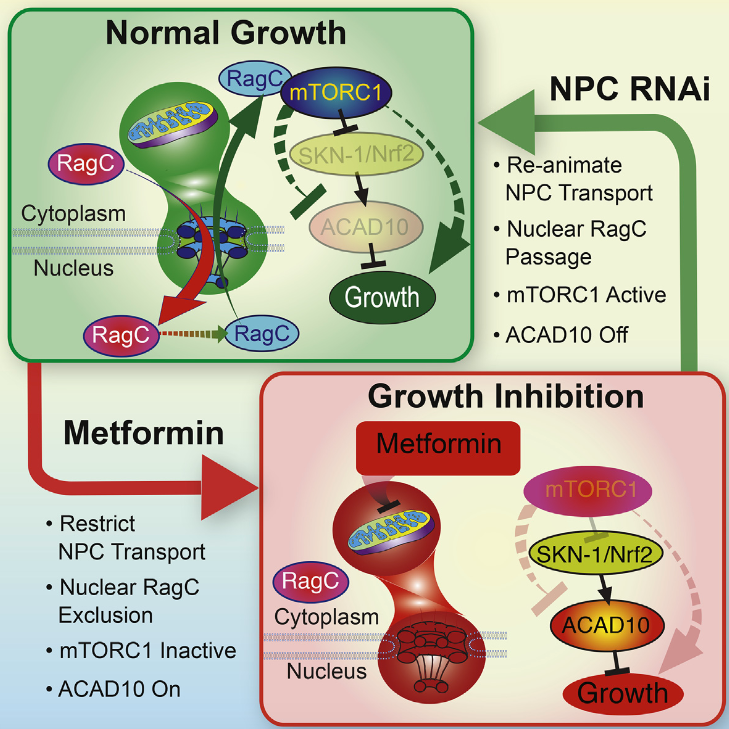How diabetes drug metformin prevents, suppresses cancer growth
December 16, 2016

Metformin growth inhibition process (credit: Lianfeng Wu et al./Cell)
A team of Massachusetts General Hospital (MGH) and Harvard Medical School investigators has identified a pathway that appears to underlie the apparent ability of the diabetes drug metformin to both block the growth of human cancer cells and extend the lifespan of the C.elegans roundworm.
That finding implies that this single genetic pathway may play an important role in a wide range of organisms — including humans.
“We found that metformin reduces the traffic of molecules into and out of the nucleus — the ‘information center’ of the cell,” says Alexander Soukas, MD, PhD, of the MGH Center for Human Genetic Research, senior author of the study, published in the Thursday, Dec. 15 issue of Cell.
“Reduced nuclear traffic translates into the ability of the drug to block cancer growth and, remarkably, is also responsible for metformin’s ability to extend lifespan,” he said. “By shedding new light on metformin’s health-promoting effects, these results offer new potential ways that we can think about treating cancer and increasing healthy aging.”
Several studies have suggested that individuals taking metformin have a reduced risk of developing certain cancers and of dying from cancers that do develop. Current clinical trials are testing the impact of metformin on cancers of the breast, prostate and pancreas; and several research groups are working to identify its molecular targets.
How Metformin lowers blood glucose — and growth
Metformin’s ability to lower blood glucose in patients with type 2 diabetes appears to result from the drug’s effects on the liver. The drug reduces the liver’s ability to produce glucose for release into the bloodstream. Metformin has been thought to block the activity of mitochondria — structures that serve as the powerhouse of the cell.
But Soukas says more recent information suggests the mechanism is more complex. The Soukas team found a genetic pathway that slows the growth and extends the lifespan of C.elegans roundworms. That suggests that the roundworm could serve as a model for investigating the drug’s effects on cancer.*
“Amazingly, this pathway operates identically, whether in the worm or in human cancer cells,” says Soukas, who is an assistant professor of Medicine at Harvard Medical School. “Determining exactly how [it] slows cell growth will provide additional insights into novel therapeutic targets for cancer and possibly ways to manipulate the pathway to promote healthy aging.”**
Support for this study includes National Institutes of Health grants, a Broad Institute SPARC Grant, and the Ellison Medical Foundation New Scholar in Aging Award.

Metformin both suppresses cancer cell growth and promotes organismal longevity through a key transcriptional target that is induced through inhibition of mitochondrial respiration and modulation of mTOR signaling. (credit: Lianfeng Wu et al./Cell)
* The Soukas team’s experiments found that metformin’s action against cancer relies on two elements of a single genetic pathway – the nuclear pore complex, which allows the passage of molecules into and out of the nucleus, and an enzyme called ACAD10.
Basically, metformin’s suppression of mitochondrial activity reduces cellular energy, restricting the traffic of molecules through the nuclear pore. This shuts off an important cellular growth molecule called mTORC1, resulting in activation of ACAD10, which both slows the growth and extends the lifespan of C.elegans.
In human melanoma and pancreatic cancer cells, the investigators confirmed that application of drugs in the metformin family induced ACAD10 expression, an effect that depended on the function of the nuclear pore complex.
Without the complete signaling pathway – from mitochondrial suppression, through nuclear pore restriction to ACAD10 expression – cancer cells were no longer sensitive to the effects of metformin-like drugs.
** “Our experiments showed two very important things: if we force the nuclear pore to remain open or if we permanently shut down ACAD10, metformin can no longer block the growth of cancer cells. That suggests that the nuclear pore and ACAD10 may be manipulated in specific circumstances to prevent or even treat certain cancers.”
The essential contribution of ACAD10 to metformin’s anticancer action is intriguing, Soukas adds, because the only published study on ACAD10 function tied a variant in the gene to the increased risk of type 2 diabetes in Pima Indians, suggesting that ACAD10 also has a role in the drug’s antidiabetes action. “What ACAD10 does is a great mystery that we are greatly interested in solving,” he says.
Abstract of An Ancient, Unified Mechanism for Metformin Growth Inhibition in C. elegans and Cancer
Metformin has utility in cancer prevention and treatment, though the mechanisms for these effects remain elusive. Through genetic screening in C. elegans, we uncover two metformin response elements: the nuclear pore complex (NPC) and acyl-CoA dehydrogenase family member-10 (ACAD10). We demonstrate that biguanides inhibit growth by inhibiting mitochondrial respiratory capacity, which restrains transit of the RagA-RagC GTPase heterodimer through the NPC. Nuclear exclusion renders RagC incapable of gaining the GDP-bound state necessary to stimulate mTORC1. Biguanide-induced inactivation of mTORC1 subsequently inhibits growth through transcriptional induction of ACAD10. This ancient metformin response pathway is conserved from worms to humans. Both restricted nuclear pore transit and upregulation of ACAD10 are required for biguanides to reduce viability in melanoma and pancreatic cancer cells, and to extend C. elegans lifespan. This pathway provides a unified mechanism by which metformin kills cancer cells and extends lifespan, and illuminates potential cancer targets.